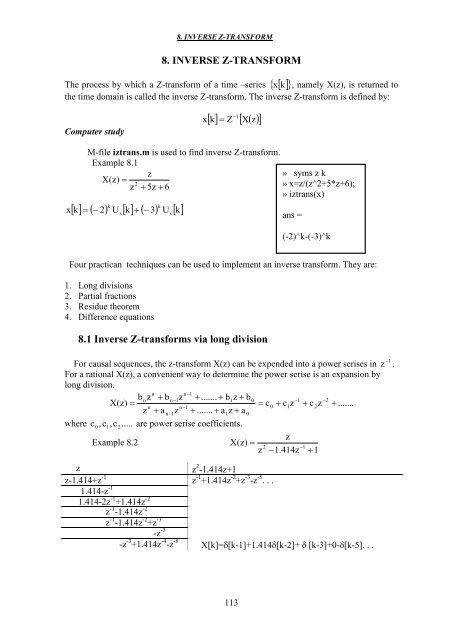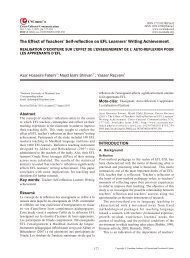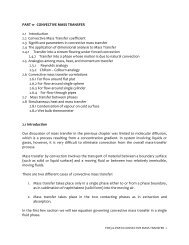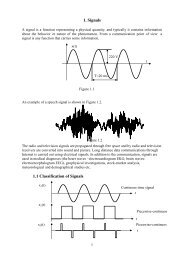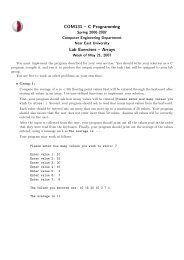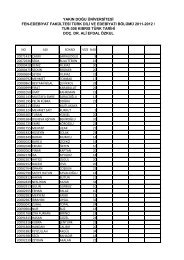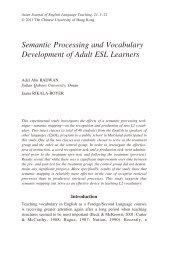8. inverse z-transform
8. inverse z-transform
8. inverse z-transform
Create successful ePaper yourself
Turn your PDF publications into a flip-book with our unique Google optimized e-Paper software.
<strong>8.</strong> INVERSE Z-TRANSFORM<strong>8.</strong> INVERSE Z-TRANSFORM The process by which a Z-<strong>transform</strong> of a time –series x k , namely X(z), is returned tothe time domain is called the <strong>inverse</strong> Z-<strong>transform</strong>. The <strong>inverse</strong> Z-<strong>transform</strong> is defined by:Computer studyxk Z1 X zxM-file iztrans.m is used to find <strong>inverse</strong> Z-<strong>transform</strong>.Example <strong>8.</strong>1z» syms z kX(z)2z 5z 6» x=z/(z^2+5*z+6);» iztrans(x)kkk 2 U k 3 U kssans =(-2)^k-(-3)^kFour practican techniques can be used to implement an <strong>inverse</strong> <strong>transform</strong>. They are:1. Long divisions2. Partial fractions3. Residue theorem4. Difference equations<strong>8.</strong>1 Inverse Z-<strong>transform</strong>s via long division1For causal sequences, the z-<strong>transform</strong> X(z) can be expended into a power serises in z .For a rational X(z), a convenient way to determine the power serise is an expansion bylong division.nn1bnz bn1z ....... b1z b012X(z) c0 c1z c2z .......nn1z a z ....... a z an1where c0 ,c1,c2.....are power serise coefficients.zExample <strong>8.</strong>2X(z) 21z 1.414zzz 2 -1.414z+1z-1.414+z -1 z -1 +1.414z -2 +z -3 -z -5 . . .1.414-z -11.414-2z -1 +1.414z -2z -1 -1.414z -2z -1 -1.414z -2 +z -3-z -3-z -3 +1.414z -4 -z -5 X[k]=[k-1]+1.414[k-2]+ [k-3]+0-[k-5]. . .101113
<strong>8.</strong> INVERSE Z-TRANSFORMComputer studyThe <strong>inverse</strong> of a rational z-<strong>transform</strong> can also be readıly calculated using MATLAB. Thefunction impz can be utilized for this purpose. Three versions of this function are asfollows: [h,t]=impz(num,den) [h,t]=impz(num,den, L) [h,t]=impz(num,den, L, FT)Where the input data consists of the vector num and den containing the coefficients of thenumerator and the denominator polynomials of the z-<strong>transform</strong> given in the descendingpowers of z, the output impulse response vector h, and the time index vector t. The firstform, the length L of h is determined automatically by the computer with t=0:L-1,whereas in the remaining two forms it is supplied by the user through the input data L. In1the last form, the sampling interval is . The default value of FT is 1. The following twoFTh , t impz num,den file to and plot power.examples show application Example <strong>8.</strong>3X ( z)2zz1.414z1z» num=[1 0];Power series coefficiens for X ( z)2» den=[1 -1.414 +1];z 1.414z1» L=8;» [x,k]=impz(num,den,L) 1.5x =1.00001.414010.9994-0.0009-1.00060.5-1.4140-0.99880.00170k =01-0.5234-1567-1.5» stem(k,x,’fill’,’k’) 0 1 2 3 4 5 6 7114k
<strong>8.</strong> INVERSE Z-TRANSFORMXzz)2z2(2 z 1 3z1Example <strong>8.</strong>4» num=[1 1 -1];» den= [2 3 1];» L=10;» [x,t]=impz(num,den,L)x =0.5000-0.2500-0.37500.6875-0.84380.9219-0.96090.9805-0.99020.9951» stem(k,x,’fill’,’k’)10.80.60.40.20-0.2-0.4-0.6-0.8-1Power series coefficients forXzz)2z2(2 z 1 3z11 2 3 4 5 6 7 8 9<strong>8.</strong>2 The Inverse Z-Transform Using Partial FractionsWe now derive the expression for the <strong>inverse</strong> z-<strong>transform</strong> and outline the twomethods for its computation.jRecall that, for z re , the z-<strong>transform</strong> G(z) given by the equation is merely the Fourierk<strong>transform</strong> of the modified sequence gkr . Accordingly, by the <strong>inverse</strong> Fourier<strong>transform</strong>, we have:gkrk12G(rej)ejkd(<strong>8.</strong>2)jBy making the change of variable z re , the above equation can be converted into acontour integral given by :k1g k residues of G(z)z at the poles inside C(<strong>8.</strong>3) Note that theequation mentioned above needs to be equated at all values of k which canbe quite complicated in most cases.A rational G(z) can be expressed as:G(z)P(z)D(z)115
<strong>8.</strong> INVERSE Z-TRANSFORMnum=[3 0 0 12];den=[2 -3.5 0 -1.5];» [r,p,k]=residuez(num,den)r =1.92193.7891 - 0.3013i3.7891 + 0.3013ip =1.9477-0.0989 - 0.6126i-0.0989 + 0.6126i 2.47 3.6 2.625X(z) z 1.5z 1z 0.5k =-8» r=[ 1.9219 3.7891 - 0.3013i 3 21.5z 3.78916z+ 0.3013i];» p=[ 1.9477 X-0.0989 (z) -30.6126i2-0.0989 +z 1.75z 0.750.6126i];» [num,den]=residuez(r,p,k)num =1.5001 -0.0000 0.0008 5.9999den =1.0000 -1.7499 -0.0000 -0.7500Multiplying the numerator and the denominator by 2.(z) 2z33z 12 3.5z 1.5G3 2Case 2. G(z) has multiple poles, for example, if the pole at z is of multiplicity r andthe remaining N-r poles are simple and at z pk ,k 1,2,3,.....N r,then the generalpartial-fraction expansion of G(z) takes the formG (z)MNk0akzkNrkiakzz pkri1ariz(1 z)1iwhere the constant a ri (no longer called the residues for i1) are computed using theformula:ri1 d r G(z) ari (z )r i , i=1,2,3,…..,r(r i)! d(z) z zExample <strong>8.</strong>72za21za22zX(z) ; X(z) 22(z 1)(z 1)(z 1)X(z)za(z 1)a2122 ; a 020a(z 1)ddz2z 1X(z)z2zX(z)(z 1)X(z) ; a21 1zzz1d zdz22z11z1117
<strong>8.</strong> INVERSE Z-TRANSFORMWhich results in the following time-seriesx k 1 kukzExample <strong>8.</strong>8 G(z) 2(z 0.5)(z 1)aG(z) (z 0.5)z1z0.5s2 G(z)4 ; a22 (z 1) 2;zd 2 G(z) a21 (z 1) 4dz z z1z z zG(z) 4 4 2z 0.5 z 1(z 1)Consider the following three cases:1) z1kg[k] 4(0.5) Uk 4Uk 2kUk12) z 22z1Usk Usk 1kg[k] (0.5) U k 1 4U k 1 2kU k 13) 21 z14ssskg[k] (0.5) U k 4U k1 2kU k 1Example <strong>8.</strong>94sss3 23z 5z 3z(z) (z 1)(z 0.5)X2a11za21za22zX(z) z 0.5 z 1(z 1)20.5 1.0z10.5 1.0z 210.5 1.01 z122where a 11z /(z 0.5)an exponential, a 21z /(z 1)a step function, and a22z /(z 1)a rampfunction. What is desired, however, is the partial fraction expansion of X(z)/z, where:whereawhich results inaX(z)z(z 0.5)X(z)za11a21a22 z 0.5 z 1(z 1)3 23z 5z 3z2z(z 1)1z0.5z0.5a2d (z 1)X(z)dz z2(z 1)X(z)zz13 23z 5z 3zz(z 1/2)229z10 3 2(3z z(z 1/2)2z1252 5z 3)(z 1/4) 2 (z(z 1/2)) 321 z1z12118
<strong>8.</strong> INVERSE Z-TRANSFORMkk 5(0.5) 2 2kukxExample <strong>8.</strong>10318zSolve using Matlab: H(z)3 218z 3z 4z 10.24 0.4 0.36(z) 1110.33z (1 0.33z ) z 0.5H 2s» num=[18]; den=[18 3 -4 -1];» [r,p,k]=residuez(num,den)r =0.24000.40000.3600p =-0.3333-0.33330.5000k =[]» [num,den]=residuez(r,p,k)num =1.0000 0.0000 0.0000den =1.0000 0.1667 -0.2222 -0.0556Using the numerator and the denominator coefficients we have:X32(z) z 0.1667z3z 0.2222z 0.0556It can be seen that the coefficients will be same as in the equation of the question if wemultiply each coefficient by 1<strong>8.</strong>Example <strong>8.</strong>11. Find the <strong>inverse</strong> Z-<strong>transform</strong> of3(z 1)X(z) (z 0.5)(z 0.5)2X(z)za0za1a21a22 (z 0.5) (z 0.5) (z 0.5)2zX(z)za0z08119
<strong>8.</strong> INVERSE Z-TRANSFORMa1(z 0.5)X(z)zz0.5(z 0.5)(z 1)2(z 0.5)3z0.51 4a222(z 0.5) X(z)zz0.53(z 1)(z 0.5)z0.5274xX(z)za212d (z 0.5) X(z)dz zz0.5ddz3(z 1)(z 0.5)z0.51 z 27 z 27 z 8 24 (z 0.5) 4 (z 0.5) 4 (z 0.5)14274274kkkk 8k( 0.5) (0.5) k(0.5) U k» num=[1 3 3 1]; den=poly([0 -0.5 0.5 0.5])den =1.0000 -0.5000 -0.2500 0.1250 0» [r,p,k]=residue(num,den)r =-0.2500-6.75006.7500<strong>8.</strong>0000p =-0.50000.50000.50000k = []s 274Case 3. X(z) has a complex pole22 Example <strong>8.</strong>12. The second-order X(z) (3z 1.5z) /(z cos( )z 1/4)has non6repeated complex roots. The partial expansion of X(z) is defined by:where =0.433 j0.25 anda1z zX (z) a1 a2 *(z )(z )X(z)z(z )X(z)za1a2 (z )(z z*)2(3z 1.5z)*z(z )z120
<strong>8.</strong> INVERSE Z-TRANSFORMAlso note thata(z )X(z)z**2 a1z*(3z 1.5z)z(z )11 kx1k Z uz 11 *x2k Z ( )*z kz*kand ukWhere =0.433013-j0.25=0.5exp(-j/6). Therefore,zX(z) a1 az 0.5exp( j/6)which corresponds to a time-series, for k0xk 1 1.55exp( j/12) 2 1 1.55 2 1 3.1 2 kkcos( k / 6 /12)k*1zz 0.5exp( j/ 6) 1 exp( jk / 6) 1.55exp( j/12) 2 (exp( jk / 6 j/12) exp( jk / 6 /12))kexp( jk / 6)which is seen to be a causal phase-shifted cosine wave with an exponentially descendingenvelope. Also observe that x0 3.1cos( /12) 3, which can be verified using theinitial value theorem.<strong>8.</strong>3 Difference EquationsLong division can be intensive and tedious computational process. If a computer-basedsignal processing is desired, the use of difference equation is generally more efficient.x k is X(z), whereAssume that the Z-<strong>transform</strong> of a time series is X (z)M b zi0Ni0i a ziiiRecall that theZnk 1and Zk n z. Therefore, it follows that:ab00xk a1xk1 .... aM1xk (M 1)aMxk Mk b k1 .... b k (N 1)b k N1N1N121


